| Main Page : About Me : Advice : Articles : Books : Curiosities : Paintings : Photographs : Seminars : Source of Life : Svetlana : Video |
The Source of Life
Part 7. The New Year surprises
Photographs taken by my wife Svetlana de Rohan-Levashov
|
It would seem that there was no reason to expect anything extraordinary to happen in our French domain after the middle of December. December is December, despite those unbelievable changes that happened with the plants within the bounds of our park and garden. Moreover, for the last several years the winter in France was very similar to that of Russia’s midlands: there were frosts of up to 20 degrees below zero, snow and ice on rivers and lakes… This kind of weather is very, to put it mildly, unusual in the Royal Valley! Well, what I can say in this respect: global “warming” is global “warming”! In 2008 night frosts began at the end of September and lasted the whole of October, and in November temperatures below zero were, very often, not only at night but also in the day-time. I wrote about it in detail in “The Source of life–6”. Nevertheless, several months of weather incompatible with life for the many subtropical, tropical, subequatorial and equatorial plants which grow in our domain could not harm them and failed to prevent these heat-loving delicate creatures from flowering and producing fruits and new, tender leaves. In short, they behaved as though they were growing in the best environmental conditions! But even with all those incredible things mentioned in the series of articles The Source of Life 1-6, the arboreal juice of all plants should move slower at such a low temperatures and, accordingly, all vital processes should slow down too! This can be true if one analyzes what is going on from the generally accepted point of view which is based on millennia of practical experience! However, it does not work in the active area of the psi-field or “dark matter” generator! From the viewpoint of “common” sense, for an ovary to appear and later to turn into a full-fledged mature fruit, there should be maximal biochemical activity in plants, which is impossible at low temperatures! Therefore fruits ripen, mainly, in summer, not in winter! However, this is true in the “correct” world, but in our “incorrect” park and garden everything is possible! I already described our Japanese Plum’s “incorrect” behaviour during the whole winter of 2007-2008 when its fruits were saturated with vital juices and fully ripened in spring. It was unbelievable; however, fruits did ripen slower than in their usual conditions (more details in “The Source of life–3” and “The Source of life–4”). But what happened with Passiflora Sayonara was a real New-Year surprise! This plant became one of the protagonists in “The Source of life–5” and “The Source of life–6” where you can find more details about this particular tropical variety which can grow in Europe only in botanical gardens! Our Passiflora Sayonaras did not die during strong frosts and calmly bore fruits. However, they reacted to the influence of the psi-field generator differently! The aggregate of many factors resulted in the same tropical vine — Passiflora Sayonara — reacting to the influence in very unusual way! The young plants were planted along the garden fence at distances varying from several metres to several tens of metres. This was sufficient for them to find themselves in different conditions, which occurred as a result of the superimposition of the generator’s effect on the natural qualitative structure of the surface. I will remind readers that Passiflora Sayonara is a hybrid produced as a result of crossing two types of tropical lianas: Passiflora Caerulea — the Blue Passion Flower — this is its Latin name translated, is a perennial herbaceous vine which can achieve 6-9 meters in height, native to southern Brazil and Argentina. Its stem is smooth and rounded, with long-rod, coriaceous, alternate three-lobed leaves which are green above and grey below. The flower is on a long peduncle, 5-7 cm in diameter, with a double perianth; petals are pale-purple, stamens are highly raised in the form of a column, pistils are numerous. There are two rings of long, threadlike, coloured fringes between the corona and stamens which give a unique beauty to the flowers. The fruit is an edible, yellow-orange berry with black seeds. The Blue Passion Flower blooms in July-August and can flower almost the whole year round in its natural conditions in South America. Passiflora amethystine (Passiflora) Tocaja — is native to Brazil. It has violet flowers. The fruit is of oval form and violet colour. They achieve a size of 5-6 cm. In Europe this Passiflora can grow only in closed and well heated quarters. The fruits acquire a violet colour only when growing in subtropical conditions. More details in “The Source of life–6”. Thus, Passiflora Sayonara is a hybrid of the tropical vine Passiflora Caerulea and subequatorial vine Passiflora amethystine which differ not only in optimal growing conditions, but also in the form and colour of the leaves, flowers and fruits. It is of interest that any hybrid gets half of its chromosomal set from each “parent” and, thus, differs from both of them! So, Passiflora Sayonara has one half of its chromosomal set from “Caerulea” and the rest – from “Amethystine”. When the chromosomes join, a new combination of genes appears where some genes become dominant, and others — recessive (passive). Therefore, a certain form and colour of flowers, leaves and fruits etc, are inherent in a hybrid, depending upon which of the gene or genes responsible for this in the new combination become dominant! This mini-lecture about basics of genetics was necessary to explain what happened in our domain with Passiflora Sayonara within the generator’s active area. I would like to emphasize that the young plants of this hybrid were planted along the garden fence simultaneously and were taken from one and the same place. Such clarification is very important to indicate that all the new Passiflora Sayonaras had the same “parents” and were totally identical at the genetic level! So, absolutely genetically identical Passiflora Sayonaras are in the active area of the psi-field generator, the influence of which was superimposed on the natural structure of the place which has its own influence on living biomass, just as any other place on Midgard-earth does. I will remind readers that before I established the psi-field generator, no “wonders” whatsoever were observed on the lands of our castle for the many centuries of its existence. And here it is… the generator’s psi-influence is superimposed on the natural structure of the place! Furthermore, we are able to observe not only new qualities and properties which plants and animals have acquired, but a unique, in its essence, phenomenon, the understanding of which will allow us to make the next qualitative jump in possible harmonious co-operation with Nature: when man will stop interfering barbarously, mechanically and genetically, in that which was created by Nature! It was precisely pragmatism which prompted this qualitatively new approach of co-operation with Nature! And chance! Oh, yes, exactly Chance suggested a fundamentally new method of real co-operation with Nature! It was young Passiflora Sayonaras that did this and here is why... I already mentioned that after the young Passiflora Sayonaras were planted in our garden they began to behave very strangely, the reason for which was the superimposition of the generator’ influence on the qualitative structure of the place where they grow. This, in its turn, resulted in plants placed only several metres apart looking absolutely different (Fig. 1). One and the same Passiflora Sayonara’s hybrid acquired leaves which dramatically differed in size, colour and the presence of a “waxen” coating! Roughly, we can single out two types of leaves which appeared on our Passiflora Sayonara. The first leaf-type is light-green with seven deep lobes; the second is dark green, waxy and palmate! I would like to remind readers that the leaves of one of Passiflora Sayonara’s “parents” — Passiflora Amethystina Tocaja — are light-green with three deep lobes (Fig. 2), and the leaves of its other “parent” — Passiflora Caerulea — are long-rod, coriaceous (leathery), having three deep lobes and are green from above and greyish from below (Fig. 3)! It is of interest that both “parents” have three-lobed leaves, while our Passiflora Sayonara has either five or seven-lobed leaves. The only thing that our Passiflora Sayonara’s first type leaves inherited is Passiflora Amethystina Tocaja’s light-green colour and ... that is all! There is nothing else in common which can be observed between Passiflora Sayonara and its parents! Certainly, the hybrid Passiflora Sayonara remained Passiflora, but its leaves, fruit-form, size and colour changed in the active area of the psi-generator, plus it acquired the ability to produce fruits almost continuously in the European climate conditions and in the open air at temperatures below zero! In “The Source of life–6” you can find a lot of material dedicated to “wonders” that happened to our Passiflora Sayonara owing to the generator’s working. Here I would like to pay more attention to another aspect of this phenomenon — Passiflora’s leaves! The second leaf-type differs not only in its form — five deep lobes (Fig. 1) — but also in its dark-green colour! Neither of its “parents” has such a colour! Along with the colour, the leaves of the second type differ also in their “waxen” coating which is much more strongly expressed than in the “parent” — Passiflora Caerulea! But this is not all! The size of the second type leaves is five to six times bigger than the leaves of both its “parents” and its twin with the first type leaves (Fig. 4). It is also of interest that the very form of the second type leaf differs. There are five, three and even two-lobed leaves within the second type (Fig. 5). They all are simply enormous compared to the first leaf-type of Passiflora Sayonara. I did not pay much attention to the second type leaves in “The Source of Life – 6”, because except for their big size, nothing special happened with them till the middle of November, 2008 and Passiflora Sayonara with the first type leaves of a relatively small size surprised us by the size, form and colour of its fruits and the duration of fruiting. (More details about it in “The Source of life – 6”). At first there was even an impression that Passiflora Sayonara with the second type leaves implemented all its force in the change of leaves! But it was not so, simply it was “preparing” a surprise for all! Passiflora Sayonara with the second type leaves did not flower during the whole summer and autumn which is quite normal, for those in their second year, which grow outside our French domain. Can you imagine Svetlana’s great surprise when she saw mature fruits on our Passifloras with the second type leaves in the middle of December (Fig. 6)! Moreover, there were fruits of two generations on them! Regrettably, their flowering passed unnoticed, because nobody expected that they would “decide” to flower in December, but the fruits on the lianas speak for themselves (Fig. 7 and Fig. 8)! To tell the truth, it is a strange feeling to see the fruits and leaves of a tropical and subequatorial vine realizing that it is he second half of December, that there are biting frosts at night and in the day-time, that a temperature of 16 degrees below zero was just several days ago and the next day there was a rise in temperature above zero and a winter rain, and again there was frost at night, 10 degrees below zero! The daily temperature variation was more than thirty degrees! |

Fig.1 |
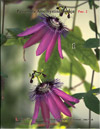
Fig.2 |
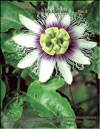
Fig.3 |

Fig.4 |

Fig.5 |
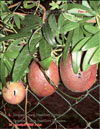
Fig.6 |
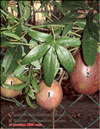
Fig.7 |
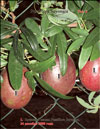
Fig.8 |
|
Nevertheless, the leaves became green and the fruits ripened as if nothing happened; but this is a very heat-loving plant! Moreover, Passiflora Sayonara with the leaves of the second type produced new shoots with young leaves (Fig. 9 and Fig. 10)! There is another very curious fact! Any reference book says that the fruits of Passiflora amethystine Tocaja, native to Brazil, acquire violet colour only in their Motherland and never acquire a violet shade outside their natural environment even in greenhouses! Well, we can observe that our Passifloras with leaves of the second type ripen fully and do acquire a violet shade in December and in the open air with biting frosts present (Fig. 11 and Fig. 12)! Moreover, they ripen without any signs of congelation and being brought inside, they look just like fruits that ripened in summer. Also, mature fruits not only failed to turn into icicles, but ripened fully which from the point of view of modern concepts also cannot be ! It cannot be, but, nevertheless, it exists! Mature fruits are 9-10 cm long and 6-7 cm wide (Fig. 13 and Fig. 14)! There are two fruits in the photo of December 27 — one is fully mature, and the other is in the process of ripening. So, a still “green” fruit has the maximal size which, according to the reference data, Passiflora Sayonara’s “parents” can achieve! In its turn, the mature fruit looks just like Hercules! So, December did not render any influence whatsoever to Passiflora Sayonara’s fruits, either on their size, or their taste. Their external appearance and taste corresponded to the highest standards: Svetlana was the main expert as she could compare the taste of summer fruits with that of winter. Our Passiflora Sayonara with the leaves of the second type was not the only one that produced fruits in December. Certainly, it was the first fruiting for them and distinguished, primarily, by the fact that the flowering and fruiting began in December: whilst our Passiflora Sayonara with leaves of the first type began to bear fruit as early as the end of July and ... has not stopped since then. Their fruits ripened in December too, although, a little earlier than their “lazy” twins — in the first ten days of December (Fig. 15). Despite the frost, they calmly ripened by the middle of December (Fig. 16). |
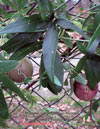
Fig.9 |
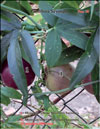
Fig.10 |
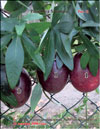
Fig.11 |
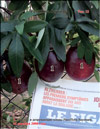
Fig.12 |
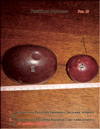
Fig.13 |
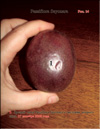
Fig.14 |
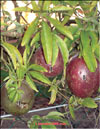
Fig.15 |

Fig.16 |
|
At that, the fruits of two December generations with several day difference, ripened simultaneously (Fig. 17 and Fig. 18). On seeing fresh leaves and mature fruits, it is somehow hard to realize that all this takes place in December in the northern hemisphere, but the background of the photo with a magazine dated December 12, 2008 is a sure evidence, although Svetlana took the photos on December 14th. It is just that she cannot buy magazines for every day of the week; actually, it is not so important what date is on the magazine — December 12 or 14, it is important that this is December... Obviously, Passiflora Sayonara with the first type leaves “decided” to keep the “honours” for duration of productivity and get the leadership in winter fruiting, winning over Passiflora Sayonara with the second type leaves for this title. I must say that they succeeded in this. Have a look at their ripening fruits on January, 7th at the day temperature of -14 degrees Celsius with abundant snow around and on their leaves — this is impossible to surpass (Fig. 19)!. The fact that the fruits of Passiflora Sayonara with the first type leaves ripened in the first ten days of January indicates that the flowering was in December, after the December fruits ripened! Flowering, ovary development and ripening took place accompanied by December night and day frosts which, certainly, were not less severe in January, 2009! Again, it is not a casual phenomenon! Passiflora Sayonara with the first leaf-type is literally covered with fruits like a Christmas-tree tree with decorations which look very like new-year garlands (Fig. 20)! The temperature is 14 degrees below zero and we got a lot of snow, nevertheless, the fruit is ripening quite normally and some have already ripened in such “ideal”, for them, conditions (Fig. 21)! However, Passiflora Sayonara with the leaves of the second type “decided” to win the palm back and by January 9, 2009 produced their fruits too (Fig. 22)! An enormous violet-brown fruit ripened among also enormous dark-green leaves! All leaves and fruit are full of life-force and ignore the temperature of 20 degrees below zero and the snow, which fell on January 5, 2009 and did not melt thereon! The snow carpet became thicker and frosts more severe with every passing day! So, Nature itself refutes any possible sceptical objection! Below zero temperatures lasted more than four days, the frost became heavier with every day and the day-time temperature reached -18 degrees Celsius, but… Passiflora Sayonara, a subequatorial plant, produced fruits and succulent green leaves: look at the young leaf (1) which has just peeped from a bud on the photo of January 9 (Fig. 23)! Note that a biting frost did not damage green and fleshy leaves, which are very unusual to observe covered with snow and ice sparkling in the rays of the winter Sun (Fig. 24)! |
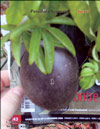
Fig.17 |
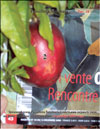
Fig.18 |
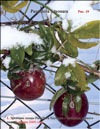
Fig.19 |

Fig.20 |
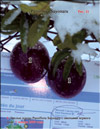
Fig.21 |
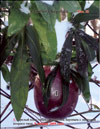
Fig.22 |
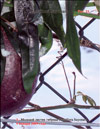
Fig.23 |

Fig.24 |
|
To make the “picture” even clearer, look at the photos of the real winter with came to the Royal valley at the beginning of January, 2009 (Fig. 25, Fig. 26, Fig. 27, Fig. 28, Fig. 29 and Fig. 30)… |

Fig.25 |

Fig.26 |
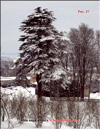
Fig.27 |
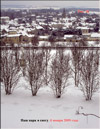
Fig.28 |
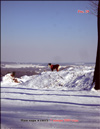
Fig.29 |
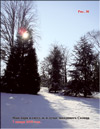
Fig.30 |
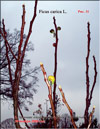
Fig.31 |
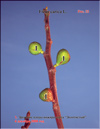
Fig.32 |
|
Thus, the fruiting of all our Passifloras allows us to draw certain conclusions. The combined influence of the psi-field (“dark” matter) generator and the natural factors of the place on Passiflora Sayonara’s young plants resulted in that different genes began to prevail in the plants of one and the same hybrid! In fact, every point of the surface is pierced by streams of primary matters (“dark” matter), and their intensity changes from place to place, just as the proportion of primary matters in these streams does. Exactly these parameters determine the influence of so-called, positive and negative geomagnetic areas. The proportional correlation and intensity of the streams of primary matters can vary very widely even within the limits of several metres or several tens of metres. Exactly this is observed in the case of Passiflora Sayonara’s young plants, when the influence of the “dark” matter generator was superimposed on the streams of primary matters which pierce the surface. His Majesty Chance allowed us to find a fundamentally new method of genetic engineering, unknown to anyone before: using the influence of the psi-field generator, it is possible to convert certain genes, which were repressed by others (and not always by the best ones), into dominants! Also, this can be done not only at the phase of an embryo or pollination, but in already fully formed young (and old) plants or other living organisms! Previously, the psi-generator created in plants and animals fundamentally new qualities and properties which they never had in Nature and which are probably fixed at the level of genetics, but this supposition requires verification. Nevertheless, everything is clear in the case of our Passifloras... Thus, there is a real possibility, not in some distant future, but today, of awakening the sleeping genes, which bear positive properties and qualities, in already existent varieties (without creating genetic monsters), and to create absolutely new properties and qualities in them which they never had initially, about which I wrote in my previous articles “The Source of Life 1-6”! These are not some theoretical suppositions, but the most real facts, as, for example, the nonfreezing arboreal juice even at temperatures more than 20 degrees below zero in tropical and subequatorial evergreens! Or the synthesis of water by plants which Mother-Nature has never created, but which can do an invaluable service to man in solving all problems related to agriculture and restoration of damaged nature! The change of dominant genes is observed in the case of Passiflora Sayonara’s young plants, as well as their acquisition of properties and qualities indicated above, for example, the nonfreezing arboreal juice at 20-22°Ñ below zero, and possibly, lower temperatures. However, we do not have any practical data regarding lower temperatures for now. It was a small “representation” and information for reflection, and meanwhile let us come back to our New-Year surprises… The fig trees surprised us too; ripening fruits can still be seen at the end of November on naked branches (Fig. 31). Although, the ripening of figs at the end of November is a very notable event, it was clear that the 2008 season of fig fruiting came to an end. Indeed, there were no figs on the naked branches for two weeks, but at the end of the first ten days of December new figs appeared on still naked branches (Fig. 32). The fig trees, taking a holiday for a couple of weeks, “decided” that they had “rested” enough and began to “work”, that is, to produce fruits. They did it quite well, despite frosts and the absence of leaves on branches! It was not a single “heroic act”. The young fig trees of the variety “Golden” (Ficus carica L.) began to produce figs too (Fig. 33). It got much warmer on the night of the 13th to 14th of December, and everything was in a milky fog the next day, through which almost nothing could be seen, but Svetlana succeeded in discerning some ripening figs and they were of a pretty big size. Unfortunately, she only had a magazine dated December 12, 2008, but the slightly out-of-date magazine, nevertheless, serves as irrefutable evidence that figs ripened within the second decade of December, 2008 (Fig. 34)! This is unbelievable, especially, taking into account biting frosts at night and in the day-time, which began in 2008 from the end of September and since then did not stop, on the contrary, they became ever more severe. Ficus carica L. liked the winter fruiting in December so much that that it continued this “front-rank experience” in January, 2009! Its fruits looked very weird during a snow-fall, when enormous snowflakes, twirling and dancing, fell on ripening figs, which probably for the first time tried snow hats (Fig. 35 and Fig. 36)! If we look closer we can see a fig full of vital force, under a snow hat, which fears neither snow nor frost (Fig. 37)! This miracle of nature showed itself to the world on January 5, 2009, when snow thoroughly covered the Royal Valley for the first time in this winter! However, this is not all! Incredible winter wonders in our domain had just begun… New cones formed on Araucaria araucanas (monkey puzzle tree) on several tiers simultaneously (more details about this exotic tree are in my articles “The Source of life–5” and “The Source of life–6”). They are filled with vital energy, probably, wishing to hold a new record in this year’s “harvest from one tree” and in the ripening of cones in critical environmental conditions at the very end December, 2008 (Fig. 38)! At the beginning of January Araucaria araucana’s cones, although not ripe yet, put on weight quite noticeably (Fig. 39)! Despite the winter, young plants not only produce cones, but also continue to grow (Fig. 40 and Fig. 41). Most likely, it was the example of the Japanese plum that inspired them to perform such a feat! |
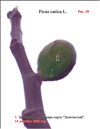
Fig.33 |
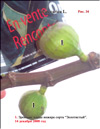
Fig.34 |
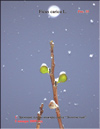
Fig.35 |

Fig.36 |
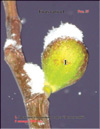
Fig.37 |
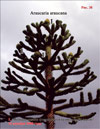
Fig.38 |

Fig.39 |
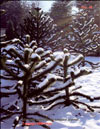
Fig.40 |
|
By the way, some words about Japanese plums! On blossoming for the next time in the middle of November, 2008, these subequatorial delicate plants obviously decided to turn into “winter-swimmers”, because it is already the second consecutive year when they produce ovaries at the beginning of winter! The ovaries began to develop accompanied by biting frosts and dancing snowflakes. Can it be that falling snowflakes strongly heat the blood, more precisely, arboreal juice of these heat-loving plants?! If we look closely at Photinia Japonica’s leaves in the middle of November, 2008 (Fig. 42) and at the beginning of January, 2009 (Fig. 43), we can easily be sure that neither frost nor snow means anything to them! Its enormous leaves, dark-green on top and light-green underneath, are covered with a thick wax-like coating and reliably protect the inflorescence and ovary both from wind and snow! Photinia Japonica’s leaves are so strong that they can easily sustain the weight of pretty heavy snowcaps (Fig. 44). They notice neither biting frosts which can last for several days, nor the weight of the snow “caps” and glow with their wax-like coating and deep dark-green colour (Fig. 45) with dignity. What “hot blood” streams in the vessels of this subequatorial evergreen, which does not “wish” to freeze and, thus, refutes all the laws of physics, according to which the arboreal juice should have congealed long since and converted these leaves into wrinkled dead vegetable organic material... But this vegetable organic material does not “want” to be dead and frozen, despite permanent frosts with snow and ice from the beginning of January! It is true that we shall wait for mature fruits of Photinia Japonica, but it does not matter. This is not a surprise, at least, for us! There is another occurrence which indeed became a complete surprise both for Svetlana and me: in one of the corners of our park she discovered the already pretty large mycelium of Grifola frondosa or Maitake (family — Albatrellaceae, genus — Grifola)! Here is what can be found about this mushroom: «…“...A Japanese name “Maitake” is related to its form which is reminiscent of a dancing butterfly. The origin of the name, when literally translated, a “dancing mushroom” (Mai-dance, take-mushroom) causes numerous discussions until now. According to one version, people who were lucky enough to find this mushroom danced for joy, because in the epoch of feudalism its weight was paid in silver. According to another version, it was necessary to perform a certain sacral dance before cutting it; otherwise the mushroom lost its properties. Sometimes it is called more plainly — “Hen of the Woods” because it looks like hen’s tail. Maitake sometimes reaches a giant size — over 50 cm in diameter and can weigh up to 4 kg. Therefore, it is no wonder that Maitake is one of the most appreciated and expensive mushrooms in Asia. Maitake is widely spread in the northeastern part of Japan and China. This rare and delicious mushroom has been appreciated in traditional Chinese and Japanese medicine for hundreds of years. Kenneth Jones, the author of books on healing mushrooms, writes that “hunters after Maitake jealously guarded their areas of collection. They walked alone and hid the places of the finds. Mycelium with more than 10 kg of mushroom was considered a true “treasure” and its location was kept in secrecy even from the family. A hunter after Maitake could take the secret of its location to the grave or whisper it to his son before death”. Indeed, Maitake was collected exclusively in wild nature up to the middle of 1980...» (The information is taken here). Surprise, surprise! One of the most appreciated and curative mushrooms, a “mushroom ginseng”, appeared in our park. It was a wild mycelium that appeared and it was exactly the wild mushrooms that were always highly appreciated both in China and Japan. Today it is almost impossible to find Maitake in the wild! But the most interesting fact in all this is that Svetlana found a mycelium on December 6, 2008! There was nothing there quite recently and nobody expected that something would “decide” to grow there in December (and grow very quickly). When Svetlana found the mycelium, it was already pretty large (Fig. 46). On December 9 Svetlana measured it. It was impressive enough: 73 cm long (Fig. 47 and Fig. 48) 58 cm wide (Fig. 49)! |
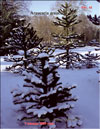
Fig.41 |
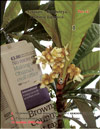
Fig.42 |
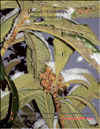
Fig.43 |
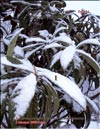
Fig.44 |

Fig.45 |
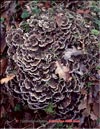
Fig.46 |
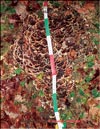
Fig.47 |
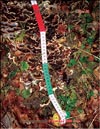
Fig.48 |
|
As I already wrote before, there were strong frosts every night and often during the day, but Maitake’s mycelium “felt” pretty good despite an icy “shirt” (Fig. 50) which became the “norm” as well as biting frost. The photo of December 10, 2008 confirms this fact (Fig. 51). Despite the icy “shirt” and frosts, the mycelium continued to grow and by December 10, 2008 had reached 80 cm long (Fig. 52 and Fig. 53)! On December 14 the mycelium became 87 cm long with the same weather conditions (Fig. 54 and Fig. 55)! Maitake’s mycelium grew wider too which is evident from photos, but it grew in length in quite a curious way — only in one direction, and began to look more like a cramp-fish (electric ray) with a sharp tail with every passing day. The icy “shirt” grew too which is perfectly visible in the photo of December 24, 2008 (Fig. 56). Indeed, it is a very exceptional phenomenon… as is everything going on in our domain. |
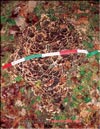
Fig.49 |
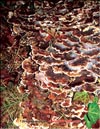
Fig.50 |
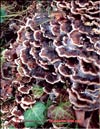
Fig.51 |

Fig.52 |
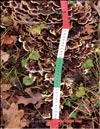
Fig.53 |
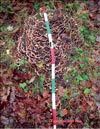
Fig.54 |
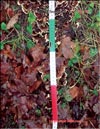
Fig.55 |

Fig.56 |
|
Another “oddity” of the rapidly growing Maitake’s mycelium was that it grew in limestone, hard like a stone because of the frost, not on a stump or dead tree, which makes the event even more remarkable. Each component of this mushroom “mega-city” was healthy and without any signs of congelation or frost-bite. It is perfectly visible on the photo taken in December 25, 2008 on the background of a newspaper of December 23 (Fig. 57). At the same time Maitake’s “mega-city” grew not only in length and width, but also in height, gradually turning into a multistoried one (Fig. 58). By December 25 Maitake’s mycelium with its “tail” was 100 cm long (Fig. 59 and Fig. 60) and 68 cm wide (Fig. 61)! At the same time, mycelium-“mega-city” began to acquire “city-satellites” (Fig. 62)! On January 1, 2009 Svetlana discovered that Maitake had also developed a usual, for them, environment — the stumps! There were six new “settlers” of this kind! Certainly, they did not have time to settle themselves properly in their new “compartments”, but I am sure they will (Fig. 63 and Fig. 64). |
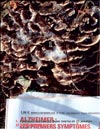
Fig.57 |

Fig.58 |
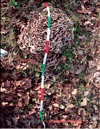
Fig.59 |

Fig.60 |
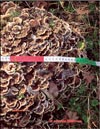
Fig.61 |
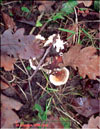
Fig.62 |
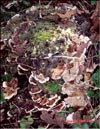
Fig.63 |
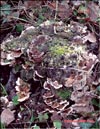
Fig.64 |
|
On January, 5, 2009, mycelium-“mega-city” was covered with snow, as were all European cities (Fig. 65)! By January 9, 2009 the Maitake’s mycelium was covered with so much snow that Svetlana could only find it with great difficulty; it could hardly be seen for snow and Svetlana did not want to step on this mushroom-“mega-city” by accident (Fig. 66)! Now we just have to wait until it reappears and can only surmise what size it will have reached in its “under-snow” development!.. Another “Japanese” mushroom, Shiitake, was not going to yield its pioneering position! In December it became yet more “fleshy”, so that any “native” seeing it would have “died” of envy, and the glade was literally covered by them! “Plump” Shiitake put their enormous tender brown-cream caps under December Sun (Fig. 67). They are not especially selected “athletes”: almost every Shiitake-mushroom is of the same size in our domain (Fig. 68). Each mushroom is worm-clean; the structure of its cap visibly demonstrates its health and the life-force accumulated in it (Fig. 69). Days passed by and our Shiitakes became very much bigger (Fig. 70) despite the date being December 10! The stronger the night frosts, the more “fleshy” our Shiitakes became and their number continued to increase (Fig. 71)! The “mushroom health” became stronger with frosts: probably, regular “exercise” regarding frost-conditioning was of enormous benefit for them (Fig. 72)! At the end of December their bodies are still in perfect shape, the caps are dense, stems are clean, laminas are even and of white colour. … |
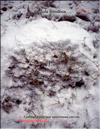
Fig.65 |
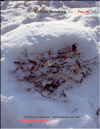
Fig.66 |
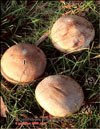
Fig.67 |
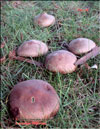
Fig.68 |
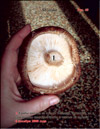
Fig.69 |

Fig.70 |

Fig.71 |

Fig.72 |
|
Everyone who knows something about Shiitake would be very surprised on seeing all this, and taking into account their size, the time and weather conditions in which these mushrooms came into the world and grew, all this passes into the category of unbelievable phenomena! Nevertheless, the newspaper dated December 23, 2008, in the background of the photo of Shiitakes which was taken on December 25, makes these “unbelievable” phenomena into objective reality! But the unbelievable things happening with Shiitake were not over yet! Regardless of all Natural laws, they continued to grow in the icy soil, as did many other plants of our domain. Their bodies grew more in a couple of days surprising us with their size again (Fig. 73). The lower the night temperature was, the more Shiitake grew. One cannot simply believe his eyes when he sees mushrooms completely undamaged by frost and green grass in hoarfrost (Fig. 74)! This could be somehow explained, if this picture dated December 27, 2008 was taken immediately after the frost had struck! Alas, this is not a natural variant of rapid congelation of grass and mushrooms. In fact, frozen mushrooms do not grow; frozen plants do not flower and do not produce fruits, which, (as they should), appear from an ovary after the flowering, frozen trees and lianas do not produce new leaves, etc. The snow which fell at the beginning of January 2009 and frosts of 20 degrees below zero did not change Shiitake’s conduct. They (as well as all other mushrooms) “went underground”, more precisely “under snow”, and they were hard to discover (Fig. 75), but the mushrooms which happened to be “caught” were still strong and healthy (Fig. 76)! Snow complicates the search, but Svetlana’s attentiveness does not give them much chance. Here is another “captive” mushroom, that snow camouflage did not help (Fig. 77). The noble Royal mushroom “Frenchman” decided not to yield to the “Japanese”, and furthermore, it was on his native land. Although just “woken up” after a more than several hundred years sleep, his “blood” had not “cooled off”! The Royal mushroom (Agaricus black) decided to outnumber them and sent a large “landing” party to the surface on December 25, 2008 (Fig. 78)! Although the “Frenchmen” did not have enough time to strengthen their bodies properly on the territories “illegally” occupied by the “Japanese”, nevertheless, their firm stems and elegant “royal musketeer hats” indicate that the young “Frenchmen” have a good potential for growth (Fig. 79)! All for one (Fig. 80)! |
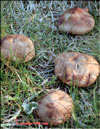
Fig.73 |
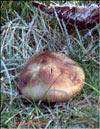
Fig.74 |
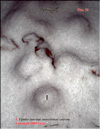
Fig.75 |
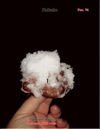
Fig.76 |
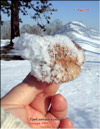
Fig.77 |
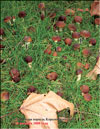
Fig.78 |
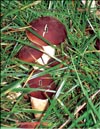
Fig.79 |
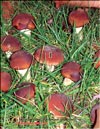
Fig.80 |
|
The newspaper dated December, 23 (Fig. 81) proves that they all returned from a long absence in time, despite their “slightly” prolonged sleep, but a healthy organism always has a “good sleep” — it is not their fault that the natural “alarm clock” began to ring several hundred years later after quite a thorough repair! But not only these lads decided to show their “Nordic” character! Tender and refined mushrooms Coprinus comatus “decided” to prove that their “court dress” did not mean that they were unable to do something exceptional! Coprinus comatus “decided” to appear in its summer clothes at the end of November (Fig. 82). “Slightly” cold weather made this lightly dressed fashion-plate gain a little weight, but it remained only till the middle of December (Fig. 83). Chanterelles (Cantharellus cibarius), on the contrary, feel totally at home in these conditions (Fig. 84)! Chanterelle-sisters simply enjoyed freedom and Sun during the whole December and the beginning of January (Fig. 85 and Fig. 86 - young chanterelles)! Tender oyster mushrooms (Preurotus ostreatus) held out till December too and their moist caps could be seen in the glades still on November, 30 (Fig. 87)! Winter Armillaria (Flammulina velutipes), probably, decided to take a “holiday” till spring (unlike others, they are well acquainted with winter); they were seen for the last time at the end of November, 2008 (Fig. 88). |

Fig.81 |
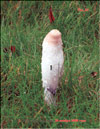
Fig.82 |
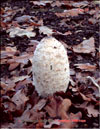
Fig.83 |
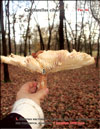
Fig.84 |
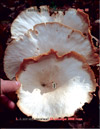
Fig.85 |
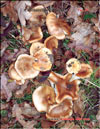
Fig.86 |
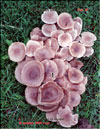
Fig.87 |
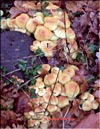
Fig.88 |
|
Having heard about such a “fuss” in our domain, a red orange-cap boletus (Leccinum scabrum) appeared for the first time at the end of November (Fig. 89)! Before I finish this article, I would like to remind readers about the protagonists of other publications! It has been several years now that our palms have felt at home with frost and snow (Fig. 90)! The snow cap looks very elegant on a palm. Magnolias caduc decided to hold another record in 2009! It was 20 degrees Celsius below zero, but buds began to swell on naked branches and we can see a light-green fluff of young leaves ready to open (Fig. 91 and Fig. 92). Look for yourself that everything is all right with the swelling buds (Fig. 93). |
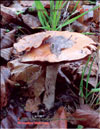
Fig.89 |
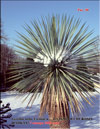
Fig.90 |
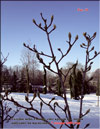
Fig.91 |
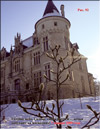
Fig.92 |
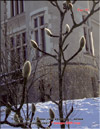
Fig.93 |

Fig.94 |
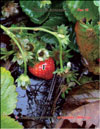
Fig.95 |
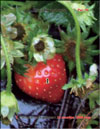
Fig.96 |
|
I would like to finish the article about New-Year surprises by mentioning the strawberries. This ordinary and well-known plant became a real hero-record-holder! In 2008 it flowered and produced nine months consecutively! Mature berries could be picked even in the middle of December which is confirmed by the photo with a magazine dated December 12, 2008 (Fig. 94)! In this picture we can see mature berries, new ovary and just faded flowers with still preserved white petals. It is also a surprise to see a lot of new, emerald-green leaves which are more dense and strong than their elder “brothers”! It is of interest that tender and sensitive to frost mature strawberries peek out from under the leaves without any sign of being frost-bitten (Fig. 95)! Here is the same photo in close-up (Fig. 96). We can see that not only the berries are completely all right, but that leaves and peduncles are not damaged by frost and ... everything is alive… Nicolai Levashov, January 13, 2009
|
| Main Page : About Me : Advice : Articles : Books : Curiosities : Paintings : Photographs : Seminars : Source of Life : Svetlana : Video |